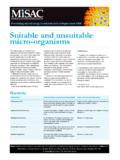Transcription of Identification and characterization of Aspergillus flavus ...
1 Identification and characterization of Aspergillus flavus and aflatoxins P. Rodrigues1,2, C. Soares1, Z. Kozakiewicz1, Paterson1, N. Lima1, and A. Ven ncio 1,* 1 IBB Institute for Biotechnology and Bioengineering, Centre for Biological Engineering, Universidade do Minho, Campus de Gualtar, 4710-057 Braga, Portugal 2 CIMO Escola Superior Agr ria de Bragan a, Campus de Santa Apol nia, 5301-855 Bragan a, Portugal Aspergillus flavus is the main producer of the well known carcinogenic aflatoxins. The presence of this fungus and aflatoxins is of huge concern in terms of food safety.
2 The Identification of A. flavus is not straightforward due to similarities with closely related species ( A. parasiticus and A. nomius). Also, from the biochemical point of view the closely-related species are able to produce different mycotoxins. In order to clarify the differentiation between species the Identification schemes is revisited. Selective media, data from mycotoxins production and molecular biology tools are discussed in order to clarify the concept of A. flavus species. Keywords Aspergillus flavus ; aflatoxins; cyclopiazonic acid; selective media; PCR primers 1.
3 Introduction Aspergillus is a large genus composed of more than 180 accepted anamorphic species [1], with teleomorphs described in nine different genera [2]. The genus is subdivided in 7 subgenera, which in turn are further divided into Sections [3]. As with fungi in general, Aspergillus taxonomy is complex and ever evolving. The genus is easily identified by its characteristic conidiophore, but species Identification and differentiation is complex, for it is traditionally based on a range of morphological features. Macromorphological features which are considered include conidial and mycelial colour, colony diameter, colony reverse colour, production of exudates and soluble pigments, presence of sclerotia and cleistothecia.
4 Micromorphology characterization is mainly dependent on seriation, shape and size of vesicle, conidia and stipe morphology, presence of H lle cells, and morphology of cleistothecia and ascospores [3]. Furthermore, all these morphological features have to be determined under standardized laboratory conditions [4] by trained mycologists, in order to obtain an accurate Identification . Several Aspergillus taxonomic keys and guides are available [3, 5]. Aspergillus Subgenus Circumdati Section Flavi, also refered to as the Aspergillus flavus group, has attracted worldwide attention for its industrial use and toxigenic potential.
5 Section Flavi is divided in two groups of species. One includes the aflatoxigenic species A. flavus , A. parasiticus and A. nomius, which cause serious problems worldwide in agricultural commodities, and the other includes the non-aflatoxigenic species A. oryzae, A. sojae and A. tamarii, traditionally used for production of fermented foods in Asia [6]. This study is focused on the first group. 2. Morphological Studies of A. flavus , A. parasiticus and A. nomius An important group of foodborne fungi are the aflatoxin producers: A.
6 flavus , A. parasiticus and more recently A. nomius. Isolates of these are maintained in all the major world biological resource centres, which are used extensively for reference and as verified isolates for mycotoxin and other research. The veracity of isolate species names associated with such collections is rarely if ever questioned. * Corresponding author: e-mail: Phone: +351 253 604413, Fax: +351 253 678986 527 Communicating Current Research and Educational Topics and Trends in Applied Microbiology A.
7 M ndez-Vilas (Ed.)_____ FORMATEX 2007 A detailed morphological study of ex-type and other isolates of A. flavus and A. parasiticus was undertaken [7]. Aspergillus parasiticus Speare originally isolated from material on sugar cane in Hawaii [8] was subsequently subcultured around the world. Light and scanning electron microscopy studies of all extant isolates disclosed conidia of two distinct ornamentations or morphs, but never mixtures of both. When these morphs were assigned to their respective cultures a sharp dichotomy was revealed.
8 One form occurs in the isolate derived from the type of A. parasiticus (Fig 1a) and the other has been established as that of A. flavus (Fig 1b). Consequently cultures for the type of A. parasiticus held in three major world collections are in fact A. flavus . More worryingly, since the publication of Kozakiewicz [7] no other than the collection at CABI, Egham, UK (formerly IMI) which has re-disbursed the particular isolates, has confirmed that these mistakes have been rectified; implying that wrongly named material continues to be sold and distributed.
9 Furthermore, in routine examinations of the IMI collection, ten additional isolates have been re-identified to date [9]. (a) (b) (c) Fig. 1 Scanning Electron Micoroscopy pictures of (a) A. parasiticus and (b) A. flavus spores, where spore ornamentation differences are clearly seen; and of (c) A. parasiticus conidial head. The situation is further complicated by the species Aspergillus nomius [10]. Morphologically, it resembles A. flavus but differs by the production of small bullet-shaped sclerotia; those in A.
10 flavus being more globose. However, it is unclear whether fresh isolates of A. nomius always produce these distinctive sclerotia. In their absence only isoenzyme patterns and mycotoxin production provide reliable Identification techniques. That is, for A. nomius the detection of aflatoxins B1, B2, G1, G2 (as does A. parasiticus), but without the detection of the secondary metabolite cyclopiazonic acid. A. flavus produces detectable aflatoxin B1 and B2 and cyclopiazonic acid only. Separation of A. flavus and A. parasiticus Contemporary diagnosis of the two species is based on the descriptions and keys of Raper and Fennell [5].



